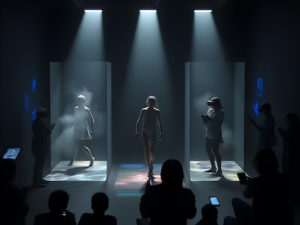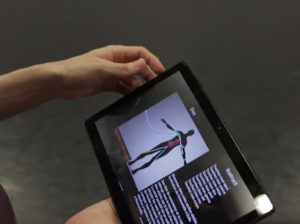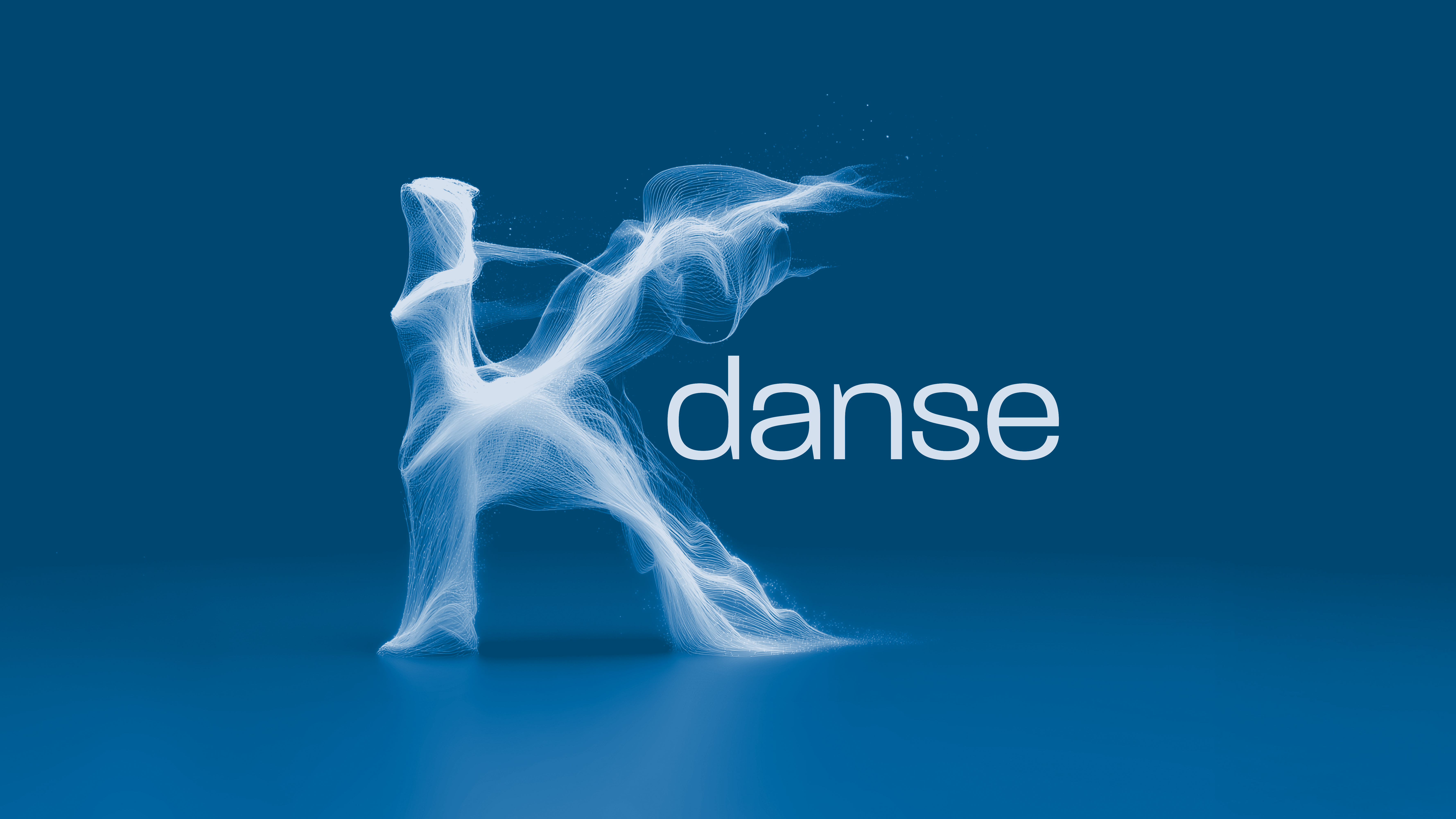
 ETERNITY project 2025 -2026-2027 dossier
ETERNITY project 2025 -2026-2027 dossier
Choreographic and interactive performance/installation, integrating contemporary dance, Artificial intelligence (AI), XR scenography, and participative audiences.
Looking for partnerships
Eternity is not infinity. It is not duration, but the thickness of the present — a constant tension between appearance and disappearance.
Between flesh and code lies a field of coexistence. And what if eternity were not elsewhere, but a way of inhabiting time by sharing it — with memory, with others,
with the machine.
Not to escape the end, but to dance it.
For to dance is already to survive oneself, if only a little.
video excerpts of an experimental performance, 2024: https://vimeo.com/1047968984
video excerpts of another experimentation, 2023: https://vimeo.com/839339385
video excerpts of a preliminary research, 2022: https://vimeo.com/784944830
The ETERNITY project explores the theme of immortality through an interactive and choreographic performative installation, integrating contemporary dance, artificial intelligence (AI), XR scenography, and audience participation. The performance, conceived by Jean-Marc Matos, imagines a techno-scientific fiction set in a future where immortal creatures, created by advanced technologies, are exhibited as curiosities, and where there is a possible physical contact between these creatures and the participating audience members.
The project features three dancers as hybrid creatures, “near-humans”, in a dark space, enclosed inside vertical and protective beams of light, and controlled by an AI. This AI coordinates interactions between the audience and the creatures, adjusting lighting, sounds, and projections based on the creatures’ reactions and audience stimuli. Visitors-spectators, free to navigate around, using their smartphones, tactile interfaces, other interactive sensors, and for some, VR headsets, can interact with the creatures, influencing their behavior and movements.
Choreographer Jean-Marc Matos and invited digital artists conceptualize the ETERNITY project, an immersive, participatory choreographic performance that brings together dance, AI, and audience interaction. This project, blending science fiction and poetic narrative, seeks to explore the nature of existence and the distinction between real and simulated emotions through a “fleshy” creature, termed “immortal,” which mediates between a coordinating AI and the audience.
The AI coordinates scenographic elements based on interactions between the immortal creatures and the audience, adapting visual, textual, and sound elements. This setup aims to evoke a matrix of strong emotions such as pain, madness, dread, and tenderness through a sophisticated choreographic expression.
Science Fiction Dance and Technological Interaction
The performance is set in a speculative future where visitors observe and interact with an immortal creature confined within a defined space by an azimuthal light projection. This setup, akin to a sideshow attraction, allows the audience to engage with the creature, making it relive past experiences through gestures and stimuli controlled via smartphones and tactile labels. The AI collects and interprets these interactions, generating new scenographic elements in response.
Dramaturgical Context
Projected into the year 2084, the ETERNITY project imagines a world where the war against death has been won, leading to the confinement of immortal beings by their creators. This narrative backdrop sets the stage for the creative experience, where the immortal, a sophisticated humanoid specimen, attempts to reconnect with humanity. The audience, free to explore and interact, becomes part of the creature’s last attempt to understand human emotions and existence.
Triangular Communication System
The performance employs a triangular communication system involving the AI, the performers, and the audience members. The AI adapts scenographic elements based on real-time data from audience interactions, while the performers respond to stimuli through movement and expression. It coordinates, suggests, interprets, invites, sometimes misleads, etc. This system ensures that the performance remains dynamic and responsive, creating a unique experience for each audience member.
Choreographic Research and the Role of AI
Jean-Marc Matos explores the movement of an immortal being by dissociating different body parts and varying rhythms, while the computer programming focuses on integrating AI into the performance. This involves the use of sensors and generative programming to create interactive and adaptive scenography. The AI’s role extends to sociological, technological, and artistic domains, including gesture tracking, automatic generation of texts, images, and sounds, and deep learning processing of movement data.
XR scenography
The entire stage setup made of the “immortal” creatures, confined within their azimuthal light columns, along with the free spaces between them and the video projection surfaces on the floor and surrounding walls, is the scenography itself for an XR mixed-reality experience. Within this environment, some audience members will be able to live a parallel journey through additional information, narrative fragments, and other audiovisual content, accessible via VR headsets.
Team
Jean-Marc Matos, choreographer
Laure Lapeyre, performer
Ariadna Logvinova, dancer performer
Stefan Veselinovic, dancer performer
Arnaud Courcelle, digital artist and programmer
Clément Combes, video artist
Flaure Diallo, costume designer
Guilhem Cléry, light designer
Required Technical and Spatial Support
Stage area of approximately 8×8 meters.
Azimuthal projectors covering an extended surface (an additional 2 meters).
Video projection systems and quadriphonic sound.
Fog machine.
Ecological and Societal Commitment
The artists aim for a sustainable approach:
- Minimizing the environmental impact of digital tools and travel.
- Using open-source software with low energy consumption.
- Reducing plastic use and encouraging DIY (Do It Yourself).
- Promoting fair social and wage conditions for all collaborators.
- Providing free or reduced-cost access to workshops and presentations, depending on available funding.
By combining poetry, technology, and performance, ETERNITY invites a speculative contemplation of immortality, where humans and machines meet and question each other.
Projected support, for future production (confirmed and under investigation)
- European Project AEPYDEA (CSGO Best) France/Bulgaria/Greece (2025-2026)
- European Project Bodynet-Khoros France/Spain/Greece (2022-2025)
- Institut Français Paris (IF digital)
- Euro-regional Project Cos(ArtEina2) Occitanie/Balearic Islands/Catalonia (Festival Ecoss, Barcelona) 2025
- City of Toulouse
- General Council of Haute-Garonne
- Bellegarde Cultural Center, Toulouse
- Cultural Services of Villeneuve-Tolosane (Toulouse Métropole)
- Le Quai des Savoirs, Toulouse
- InfoMus, Casa Paganini, Research Center, Genoa, Italy
- LAAS (Laboratory for Analysis and Architecture of Systems – CNRS, Toulouse)
Planned complementary residency locations
La Gare aux Artistes, La Vannerie, Le Quai des Savoirs (Toulouse), ArsFabrik (Combaillaux) – Cie Yann Lheureux
Projected Timeline
- Pre-conception – various remote preparations: Autumn 2025
- Research, development, tests, and experiments: Autumn 2025 – Winter 2026
- Advanced design and tests with initial audiences: January–June 2026
- Research-creation residencies, experiments, and tests with participating audiences: October–December 2026
- Further development, advanced tests, and experiments: January–July 2027
- Public premieres: Autumn 2027 (2027–2028 season)



